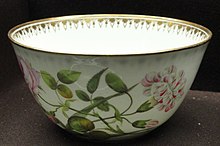In Europe, a slop bowl, slop basin or waste bowl is one of the components of a traditional tea set. It was used to empty the cold tea and dregs in tea cups before refilling with hot tea, as there were often tea leaves in the bottom of the cups.[1][2][3]


As with the rest of the tea set, most slop bowls were in pottery, but some in silver. In the 18th century they typically held about half a pint, with some room to spare. Handleless ceramic bowls of this size and shape were also used for drinking tea at breakfast, sometimes known at the time as "breakfast basins", and it is not always possible to assign a particular role to a piece; indeed they may have been made as dual-purpose pieces.[4] They became less common after about 1860, but services in the 1902 Sears Roebuck catalogue still offered them.[5]
In 2015 a slop bowl from the famous Swan Service in Meissen porcelain (originally 1737 to 1742) fetched £18,125 at a London auction, compared to £31,250 for a teacup and saucer.[6]
-
Arita ware bowl, 1650s, Japanese export porcelain
-
Silver, Philadelphia, c 1770
-
Mintons, English bone china, c. 1814
References edit
- ^ "A misleading tea complement: the waste bowl - an article on ASCAS: Association of Small Collectors of Antique Silver website". www.ascasonline.org. Retrieved 2020-06-04.
- ^ "History of the Tea Set". AC Silver. Retrieved 2020-06-04.
- ^ Savage, George, and Newman, Harold, An Illustrated Dictionary of Ceramics, 1985, p. 266, Thames & Hudson, ISBN 0500273804
- ^ Lippert, Catherine Beth, Eighteenth-century English Porcelain in the Collection of the Indianapolis Museum of Art, 1987, Indiana University Press, ISBN 0936260122, 9780936260129, google books
- ^ 1902 Sears Roebuck catalogue images
- ^ Bonham's, London sales of "Fine European Ceramics": 2 December 2015, Lots 46, 44 and 45; 17 June 2015, Lots 61 and 62 respectively. Auction results search


